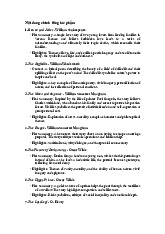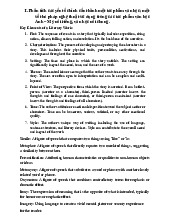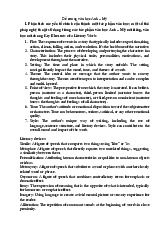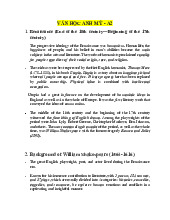







Preview text:
lOMoAR cPSD| 58950985
William Shakespeare is often hailed as the greatest writer in the
English language and the world's pre-eminent dramatist. Born around
1564 in Stratford-upon-Avon, England, Shakespeare's plays have
been performed on stages worldwide for centuries and continue to be studied and analyzed today.
Shakespeare's body of work is vast and varied, encompassing
approximately 38 plays, 154 sonnets, and two long narrative poems.
His plays span a wide range of genres, including: Hamlet, Romeo and Juliet, Macbeth
One of his most well-known plays is "Romeo and Juliet," a sad tale
of two lovers from families who hate each other. Romeo, the young
man in love, has become a symbol of both love and sadness.
Romeo is a sensitive and romantic young man. He feels emotions
strongly, especially love. He falls head over heels for Juliet right away
and would do anything to be with her. His love isn't just a feeling, it's
a belief that they can be happy together forever.
But Romeo also struggles with inner conflict. He wants love with
Juliet, but his family and Juliet's family are enemies. This fight
between families makes him feel terrible.
Because Romeo is young and doesn't have much experience, he
sometimes makes quick decisions without thinking. He lets his strong
feelings cloud his judgment, causing him to act impulsively without considering the consequences.
Romeo is willing to give up everything, even his life, to be with Juliet.
This selfless act shows how deep his love is and how brave he can be.
Symbol of Love: Romeo represents young love, which is passionate
and intense. His love for Juliet is one of the most famous love stories ever written.
A Lesson to Learn: Romeo also reminds us of the dangers of making
quick decisions based on emotions. When love is blind, people might
make choices that lead to tragedy. lOMoAR cPSD| 58950985
Reflection of Society: The story of Romeo and Juliet isn't just about
love; it also reflects problems in Shakespeare's time, like family feuds,
social class, and the bad effects of hatred.
Romeo is a complex character with many sides. He shows the hopes,
dreams, and sadness of young people. Through Romeo, Shakespeare
created a character who is still loved by audiences today. Romeo isn't
just a character in a play; he's a symbol of love, loss, and what it means to be human.
Juliet: A Complex Character
William Shakespeare's Romeo and Juliet is a timeless tragedy that
explores the themes of love, hate, and fate. At the heart of this play is
Juliet, a young girl whose life is tragically cut short. While often
portrayed as a romantic ideal, Juliet is a complex character with both
strengths and weaknesses. Juliet's Strengths •
Passionate and Romantic: Juliet is deeply in love with
Romeo, and her passion is undeniable. Her love is so strong
that she is willing to defy her family and risk her life to be with
him. This unwavering devotion to love is one of her most admirable qualities. •
Intelligent and Quick-Witted: Despite her young age, Juliet
is a quick thinker. She is able to come up with clever plans,
such as the plan to fake her death. This intelligence allows her
to navigate the complex and dangerous situation she finds herself in. •
Brave and Courageous: Juliet is not afraid to take risks. She
is willing to defy her family and society to be with the person lOMoAR cPSD| 58950985
she loves. This courage is admirable, even though it ultimately
leads to her tragic end. Juliet's Weaknesses •
Impulsive: Juliet's passion often leads her to make impulsive
decisions. She rushes into marriage with Romeo without fully
considering the consequences. This impulsiveness contributes to her tragic fate. •
Naïve: As a young girl, Juliet is somewhat naïve. She trusts too
easily, and she is easily manipulated by others. This naivety
makes her vulnerable to the schemes of those who wish to harm her. •
Dependent: Juliet is very dependent on others, particularly her
parents and Romeo. She struggles to make her own decisions,
and she often looks to others for guidance. This dependence
makes her vulnerable to the control of others.
Juliet as a Victim of Circumstances
While Juliet has her own flaws, it is important to remember that she
is also a victim of circumstances beyond her control. The feud
between the Montagues and Capulets creates an impossible situation
for her and Romeo. She is caught between her love for Romeo and her loyalty to her family. Conclusion
Juliet is a complex and tragic character. She is a young girl who is
caught between love and duty. Her passion, intelligence, and bravery
are admirable qualities, but her impulsiveness, naivety, and
dependence make her vulnerable. Ultimately, Juliet is a victim of
circumstances beyond her control. Her story is a timeless tale of love,
loss, and the consequences of hatred. lOMoAR cPSD| 58950985 Introduction
"William Wordsworth was a prominent English Romantic poet who,
alongside Samuel Taylor Coleridge, helped to launch the Romantic
movement in English literature with their collaborative work, Lyrical
Ballads (1798). Known for his deep connection to nature and his
exploration of the human experience, Wordsworth's poetry often
celebrated the beauty of the natural world and the power of the
imagination. Some of his most famous works include:
"I Wandered Lonely as a Cloud", Ode, Tintern Abbey
William Wordsworth's "I Wandered Lonely as a Cloud" is a beloved
Romantic poem that captures the beauty and power of nature. Through
vivid imagery and simple language, Wordsworth conveys a profound
sense of joy and peace that comes from experiencing nature.
The poem describes the speaker's solitary walk in the countryside
when he stumbles upon a field of daffodils. The sight of these golden
flowers dancing in the breeze fills him with immense joy and
happiness. Even after leaving the scene, the memory of the daffodils
continues to bring him comfort and delight. Key Themes •
The power of nature: The daffodils symbolize the beauty and
wonder of the natural world. They bring joy and solace to the
speaker and remind him of the importance of connecting with nature. •
The human connection to nature: The poem explores the
deep connection between humans and the natural world. The
speaker finds solace and inspiration in nature, suggesting that
it is an essential part of the human experience. •
Memory and imagination: The speaker's memory of the
daffodils allows him to relive the experience and find joy even
when he is far away from the scene. This suggests the power
of memory and imagination to shape our experiences. lOMoAR cPSD| 58950985 Literary Devices •
Imagery: Wordsworth uses vivid imagery to create a picture
in the reader's mind. For example, the daffodils are described
as "fluttering and dancing in the breeze," which creates a sense of movement and life. •
Personification: The daffodils are personified as "tossing their
heads" and "dancing," giving them human-like qualities. •
Simile: The speaker compares himself to a cloud, floating
"lonely as a cloud." This simile emphasizes his sense of
solitude before encountering the daffodils. Conclusion
"I Wandered Lonely as a Cloud" is a timeless poem that celebrates the
beauty and power of nature. Through simple yet evocative language,
Wordsworth captures the joy and peace that can be found in the natural
world. The poem reminds us of the importance of connecting with
nature and finding solace in its beauty. 3 điểm
* The Renaissance and William Shakespeare: A Perfect Harmony
William Shakespeare is one of the greatest writers in the world, and
his works have left a deep impression on readers for centuries. His
writing career flourished during the English Renaissance, a period
marked by the rebirth of European culture, art, and thought. lOMoAR cPSD| 58950985
The Renaissance: Fertile Ground for Creativity
The Renaissance was a transitional period between the Middle Ages
and modern times in Europe. It was a time when people began to
rediscover the cultural and artistic values of ancient Greece and Rome,
and at the same time, affirmed human values and creativity.
Key characteristics of the Renaissance: •
Humanism: Humans became the center of the universe, with
their own desires, emotions, and ideals. •
Artistic creation: Painting, sculpture, architecture, and
literature all developed rapidly, producing classic works. •
Scientific exploration: People began to explore the natural
world, laying the foundation for the development of modern science.
Shakespeare and the Renaissance
Shakespeare lived and wrote during the Renaissance, and his works
bear the strong imprint of this era. •
Character psychology: The characters in Shakespeare's
works are multi-dimensional, with complex inner conflicts,
clearly reflecting the humanistic spirit of the time. •
Diverse themes: Shakespeare explored many different
themes, from love, hatred, and power to social and philosophical issues. •
Rich language: Shakespeare's language is rich, flexible, and
expressive, reflecting the development of the English language during the Renaissance.
*Shakespeare's Representative Works Reflecting the Renaissance Spirit: •
Romeo and Juliet: Love overcomes all obstacles, affirming the value of human beings. lOMoAR cPSD| 58950985 •
Hamlet: The inner struggle of a prince raises questions about
life, death, and human existence. •
Macbeth: The ambition for power leads to tragedy, reflecting
the complexity of the human psyche. Conclusion
The Renaissance provided Shakespeare with an ideal creative
environment, helping him create timeless classics. The harmony
between Shakespeare's talent and the spirit of the times has created
immortal literary values, continuing to inspire generations to come.
William Wordsworth, a pivotal figure in the Romantic movement,
infused his poetry with a profound connection to nature, a celebration
of the individual, and a deep exploration of the human mind. Let's
delve into some of the key Romantic characteristics evident in his works: •
Nature as a source of inspiration and solace: Wordsworth
often depicted nature as a living, breathing entity capable of
evoking profound emotions. In poems like "Tintern Abbey"
and "I Wandered Lonely as a Cloud," he presents nature as a
spiritual guide and a source of comfort, healing the wounds of the modern world. •
The importance of the individual experience: Wordsworth
placed great emphasis on the individual's subjective experience
and emotions. He believed that poetry should arise from
personal feelings and observations, and he often wrote about his own life and experiences. •
The power of memory: Wordsworth explored the power of
memory to shape our understanding of the past and our present.
In "Ode: Intimations of Immortality from Recollections of
Early Childhood," he reflects on the fading of childhood
innocence and the search for meaning in adulthood. lOMoAR cPSD| 58950985 •
Simple language and everyday experiences: Unlike the
elaborate language of the previous poetic era, Wordsworth
sought to use simple, everyday language to express profound
ideas. He often wrote about the lives of ordinary people and
the beauty of the natural world. •
A celebration of the imagination: Wordsworth believed that
the imagination was a powerful tool for understanding the
world. He often used vivid imagery and metaphors to create a
sense of wonder and awe in his readers.
In conclusion, Wordsworth's poetry is a rich tapestry of Romantic
themes. His exploration of nature, the individual, and the power of the
imagination continues to resonate with readers today. By examining
his works, we can gain a deeper appreciation for the Romantic
movement and its enduring legacy.



